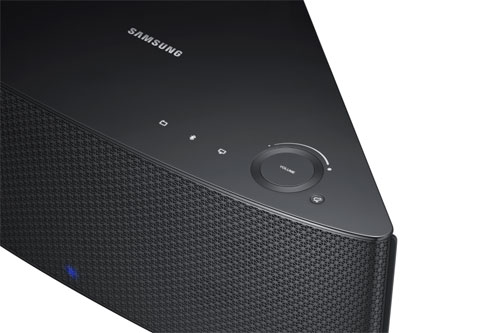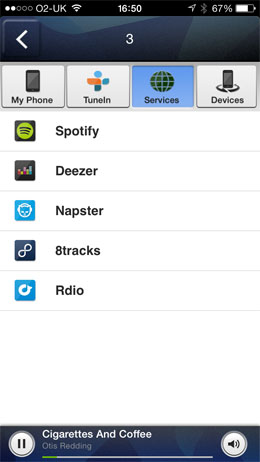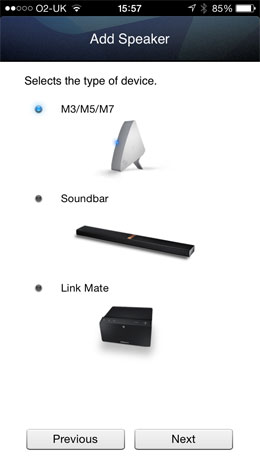It’s safe to say that when we think of wireless multi-room speakers, Sonos is the name at the top of the pile. However, Sonos’ sleeve is being tugged on by various competitors, and one seems to have a stronger grip than most. Enter the Samsung M7.

With a street price now as low as £249, the M7 we’re reviewing here is finished in black, but it’s worth pointing out that this is also available in a white finish.
Having been constantly impressed with the stylish design of the Samsung soundbars we’ve reviewed to date, the Korean manufacturer’s M7 wireless speaker is another stunning piece of engineering. Looking nothing like your average speaker, the design and shape of the M7 has been crafted to look like a play button icon. Finished in gloss black with a thin plastic strip to cover the speaker drivers, the M7 is a statement piece of furniture as well as a piece of AV equipment.

To the rear there is a plastic removable panel, which once removed reveals the various inputs the M7 has to offer, but given the nature of the product, the only one we used was the AC power input. Other inputs were the reset and pairing button, USB, and LAN socket. On top of the speaker there is a touch sensitive volume control, NFC tag, Bluetooth button, TV sound Connect button, and mute button, as well as a radio icon to flick between various broadcast stations. The Samsung M7’s file compatibility includes MP3, WMA, WAV, AAC, AIFF, ALAC, and FLAC files.
The Samsung M7 has the option of being placed either horizontally or vertically. To place the wireless speaker vertically, it comes with a clip-on stand that replaces the back panel. This is a great feature if space is an issue, and like the Samsung soundbars, the M7 has an inbuilt sensor which recognises which position you choose. It’s worth noting that when placed vertically the speaker will switch to Mono mode. Also, the Samsung M7 doesn’t come with any form of physical remote control, as everything is controlled via the Samsung multiroom app.
Set-up was an absolute breeze, and was as simple as downloading the multiroom app and following all the on-screen prompts. Within a few minutes, everything was connected and we were good to go. There are a number of ways to connect, but for us it was a simple case of connecting the Samsung M7 speaker to our smartphone over the wireless network. This involved simply selecting the M7 speaker via the app, and then holding down the WPS/ WiFi set-up button to the rear of the speaker for 5 seconds until the LED to the front of the speaker turned blue. After hitting “Next” on the app, we were given a list of networks from which we simply selected the Samsung M7. Once this was selected, the speaker and phone were paired, and we were ready to stream.
 |  |
| Samsung Multiroom app on iPhone/ iOS devices |
To add more speakers into the mix, you’ll need the Samsung WAM250 (Wireless Audio Multiroom) hub which will set you back up to £50. Just connect the hub to your router and select the “add another speaker” option via the app and follow the onscreen prompts to connect the additional speaker. Just like before, this took a matter of minutes and before we knew it we had two speakers connected.
The Samsung multiroom app is nicely laid out and really easy to use. Across the top of the interface you have the buttons [My Phone], [TuneIn], [Services], and [Devices]. [My Phone] will give you access to all the music stored on your device, and [Tunein] radio is a gateway to any kind of musical genre you could ever wish for. [Services] include the likes of Spotify and other devices gives you access to other laptops, phones or tablets you may have available on the same network.
You can also rename the speaker in relation to where it is in the home. In our case, we had our first M7 in the kitchen, and our second M7 in the living room. The only slight hiccup we encountered from the app was that when we added a new album to our iTunes account the music library on the app wasn’t updated to include the new album. The only way for the app to find the album was to uninstall it and then reinstall it. Fortunately, we didn’t have to go through the set up again but it was still a bit disappointing. Also, when selecting Spotify from the [Services] menu the Samsung M7 was unable to stream it via the speaker – the only way to stream Spotify via the M7 was through Bluetooth.
For our Samsung M7 in the kitchen (as space was an issue) we had it positioned vertically. Using the app and selecting the source button gave us access to selecting which speaker we wanted to use and how we would like to stream our content. We selected our kitchen speaker and decided to stream via Bluetooth. Initially, impressions were very good, with the M7 offering up a nice well rounded soundstage with plenty of detail from the chosen recordings. Vocals were pushed very much to the front of the mix, which left some but not all instrumentation slightly overpowered.
When switching over to Wifi streaming using the same source, we were first alarmed by the huge volume spike, but probably not as surprised as our neighbours! Speaking of volume, the Samsung M7 can go very LOUD. This is not surprising when you look under the hood. The M7 is graced with three integrated speakers, including 2 midrange drivers, 2 tweeters, and its crowning glory – a 4″ subwoofer. This setup really lends itself to heavy bass-driven music like hip-hop, electro and R&B, although be warned you’ll have to play with the equaliser, as the bass can be overbearing, robbing the soundstage of the clarity that is present at lower volumes. The EQ is limited to bass, treble and balance, but we found that we could tweak enough to get a nice sound from the M7.
The only real issue is a distinct lack of stereo separation from the Samsung M7. Once you move away from the focal listening point, the channel separation is almost gone. Now we know what you may be thinking, and you’d be right, we had it positioned vertically so it’s in mono mode. This is absolutely true, however, our other M7 in the living room was positioned horizontally, and the same lack of stereo separation was apparent. It’s better than its vertically positioned brother but not by much. You have to be sitting directly in front of the speaker to hear it at its best. As soon as you move off axis, the stereo separation we were hoping for was all but gone.
We were fortunate enough to spend a couple of weeks with both the Samsung M7s, which highlighted some really key factors that need to be considered before a purchase. As a lifestyle product it’s brilliant and will please 90% of the people that buy it. Whilst getting ready for work in the morning, I was streaming Michael Jackson’s Thriller album in the kitchen at breakfast. Then I switched to the second M7 I’d now relocated to the bedroom while I continued to get ready.
For that kind of stuff the Samsung M7 works very well, and naturally lends itself to be used for parties and other social gatherings where background music is a must – however, it wouldn’t be our first choice for sitting and listening to music. For audiophiles and people who are thinking of buying this to use purely as their main music listening source it won’t be for you, but as a lifestyle product the M7 is great.
